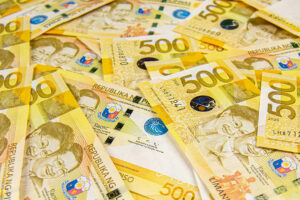Peso slides as US and China ink tariff truce

THE PESO depreciated against the dollar on Tuesday after the US and China announced they would temporarily drop additional tariffs imposed on each other.
It closed at P55.795 per dollar, 28.5 centavos weaker than its P55.51 finish on Friday, according to Bankers Association of the Philippines data posted on its website.
The peso opened weaker at P55.80 against the dollar. Its worst showing was at P55.90 while its intraday best was at P55.58 versus the greenback.
Dollars exchanged rose to $1.89 billion from $1.65 billion on Friday.
The dollar generally strengthened against the dollar on Tuesday after the US and China agreed to drop extra tariffs imposed on each other for the next 90 days, Michael L. Ricafort, chief economist at Rizal Commercial Banking Corp., said in a Viber message.
“The dollar-peso closed higher as players reacted to US-China trade deals resulting in lower tariffs,” a trader likewise said by telephone.
On Monday, the US announced it would lower the tariffs imposed on Chinese goods to 30% from 145%, while China would cut levies on US products to 10% from 125%, after trade talks in Geneva, Switzerland.
The trader expects the peso to move from P55.50 to P56 a dollar on Wednesday, while Mr. Ricafort sees it at P55.70 to P55.90.
The dollar retreated slightly on Tuesday but held most of its gains on lingering optimism over a tariff deal between the US and China, which tapped the brakes on a trade war between the world’s two largest economies.
“It’s way better than the market was expecting,” said Rodrigo Catril, senior FX strategist at National Australia Bank.
“It’s just an indication of, for one, the US administration is quite sensitive to the impact (tariffs are) having on the economy, and some would say there’s been a serious walk back in terms of what they’ve done.”
China’s yuan scaled a six-month high, peaking at 7.1855 per dollar, which in turn lifted the Australian and New Zealand dollars.
The Aussie was up 0.64% to $0.6412, while the kiwi gained 0.55% to $0.5889. The two Antipodean currencies are often used as liquid proxies for the yuan.
Elsewhere, the yen and the euro were recovering from their steep falls against a resurgent dollar in the previous session.
The yen was up 0.48% at 147.76 per dollar, having tumbled more than 2% on Monday. Similarly, the euro rose 0.25% to $1.1114, after sliding 1.4% overnight.
“In terms of magnitude, I think it’s fair to say that the big moves have been seen. But for scope for an extension of the moves, I think particularly the euro and the yen will have a bias for those moves to extend a little bit further over the coming weeks,” Mr. Catril said.
The dollar fell 0.25% against the Swiss franc to 0.8429, reversing some of Monday’s 1.6% jump. The sterling ticked up 0.16% to $1.3199.
Against a basket of currencies, the dollar hovered near a one-month high and was last at 101.54.
The de-escalation of US-China trade tensions has in turn led traders to pare back bets of Federal Reserve rate cuts, on the view that policymakers would be under less pressure to ease monetary policy to support growth.
US Treasury yields rose in tandem, with the two-year yield steadying near a one-month high at 4.009%, while the benchmark 10-year yield was last at 4.465%.
Futures show markets are now pricing in just about 56 basis points of Fed cuts by December.
“The Fed has been focused on the increase in uncertainty. This will remain the case, although the announcement may remove some of the downside risk that had been prevalent had the higher tariff rates remained in effect,” said David Doyle, head of economics at Macquarie.
Data on US inflation is due later on Tuesday, where expectations are for the core and headline number to have picked up on a monthly basis in April. — Aaron Michael C. Sy with Reuters




